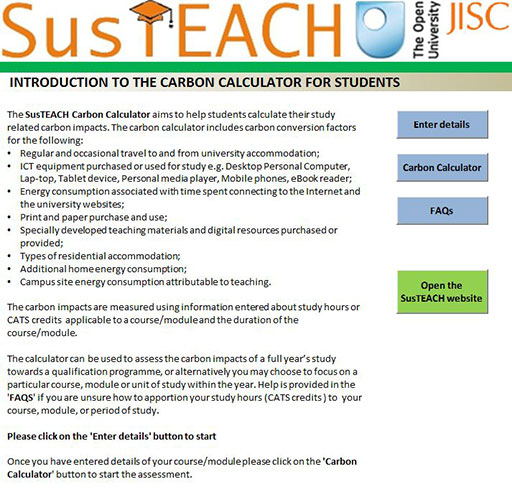3.1.2 Exploring the SusTEACH Carbon Calculator for Students
SAQ 4
Explore the SusTEACH Carbon Calculator tool with your students to calculate the energy consumption and carbon impacts associated with their learning activities on a course.
Download or open the SusTEACH Carbon Calculators for students [Tip: hold Ctrl and click a link to open it in a new tab. (Hide tip)] in Microsoft Excel to begin exploration.
Students should find the tool easy to use but the user guide is available to help to navigate through the tool.
Answer
The SusTEACH Carbon Calculator for Students helps to calculate the energy consumption and carbon impacts associated with learning activities on a course using the measure ‘per student per 100 study hours/10 CATS credits’.
Students can compare their impacts with the students in the SusTEACH study as a useful comparison. They can also compare their impacts with modes and levels of travel or ICT use that would result in similar impacts.
Box 3 presents an example of using the student calculator to calculate carbon impacts and identify actions to reduce carbon impacts.
Box 3 Using the Carbon Calculator to assess carbon impacts associated with learning activities on a course
Tavish is a full-time student on a course at a campus-based university that has a planned provision for 100 study hours (10 CATS credits), which takes place over a ten-week period. During the term he lives away from home in a university residence on campus. He cycles for all regular and occasional journeys with the exception of making one return journey of 100 miles by car (with a 1.3–1.6 litre petrol engine) between his term-time residence and usual home during a three-month period.
He purchased a laptop and uses this for five hours in a typical week for course-related learning, and spends three hours of this connected to the Internet. He did not buy any books or have educational materials provided by lecturers; although he used ten sheets for printing and five pages for photocopying in a typical week.
Using the calculator, the carbon impacts associated with his learning activities are estimated at 226 kg CO2 per 100 hours/10 CATS credits. This is slightly lower than the average student’s impacts found in the SusTEACH research project, and is quite typical for a student studying at a campus-based university.
Tavish is considering whether he could lower his carbon impacts, by living at home rather than living between two residences. This would mean that he would have to travel the 100-mile round trip to the campus every day, which he could do by rail. Using the calculator to process these details, his carbon impacts are estimated at 191 kg CO2 per 100 hours/10 CATS credits.
His impacts are lower because he has reduced the residential energy use associated with living in a university residence and because he has chosen to travel by rail. When students travel from home to attend classes this eliminates the energy impacts associated with living in university accommodation or shared houses or flats away from their usual home.
This seems to be a good idea for reducing carbon impacts but is it a sustainable approach? Tavish may decide that travelling such distances daily by train is too time-consuming and decide to drive a car (with a 1.3-1.6 litre petrol engine) instead to the campus. In this case, his carbon impacts associated with learning on the course would be estimated at 1515 kg CO2 per 100 hours/10 CATS credits.
This huge increase is because public transport is a less carbon-intensive mode of travel and sharing public transport helps to divide the CO2 emissions per passenger mile.Travelling by rail has a significantly lower carbon impact per passenger mile than travelling by petrol car with this engine size, and is only 5 per cent of equivalent travel by petrol car.
Overall, Tavish’s decision to live at home rather than at a second residence may lead to lower carbon impacts providing care is taken to use less carbon-intensive modes of travel, or to reduce the frequency or distance of journeys taken.
This example shows that there may be trade-offs between a decision to reduce residential energy consumption by living at home during studies, which could increase travel impacts. Equally there may be other trade-offs, such as between the use of paper and print and the option of reading and writing on screen using ICT devices.
You can help students to explore the impacts of making changes to learning-related activities and to consider the trade-offs between the decisions they make and the knock-on effects on carbon emissions.

